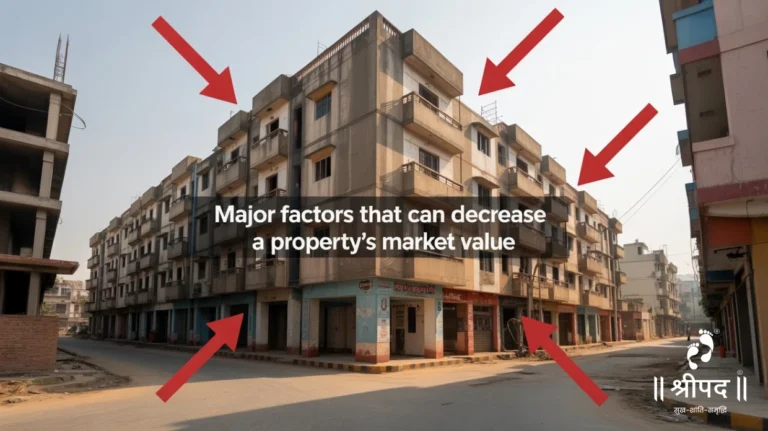- SHREEPAD GROUP
-
+91 83476 68000

Investing in real estate has always been regarded as one of the most reliable strategies for generating long-term wealth. Yet, successful property investment doesn’t depend on luck—it requires careful analysis, planning, and consistent evaluation of performance indicators. The investors who thrive in the real estate market are those who track the right metrics and make informed choices based on data rather than assumptions.
If you are new to property investment or looking to refine your existing strategies, understanding the numbers behind the deal is crucial. In this guide, we’ll highlight the key metrics every property investor should monitor, why they matter, and how you can use them to maximize profitability.
Net Operating Income (NOI)
What It Is:
NOI represents the income a property generates after deducting all operating expenses but before accounting for mortgage payments and income taxes.
Formula:
NOI = Gross Rental Income – Operating Costs
Why It’s Important:
It gives you a clear indication of the actual profitability of the property. NOI helps in comparing different properties and provides a foundation for evaluating future performance.
Pro Tip:
Be realistic about expenses. Include property management, repairs, insurance, and potential vacancies to avoid inflated numbers.
Cash Flow
What It Is:
Cash flow is the money that remains after covering all costs, including loan repayments.
Formula:
Cash Flow = Rental Income – (Operating Costs + Mortgage Payments)
Why It’s Important:
Positive cash flow ensures your property is generating income instead of draining your resources. Negative cash flow, on the other hand, could make an investment unsustainable.
Pro Tip:
Choose properties in areas with strong rental demand to ensure steady income.
Capitalization Rate (Cap Rate)
What It Is:
Cap rate measures the expected rate of return based on the property’s income.
Formula:
Cap Rate = (NOI ÷ Current Market Value) × 100
Why It’s Important:
It allows investors to compare different properties easily. Higher cap rates often mean higher returns but usually come with higher risks, while lower cap rates suggest safer but modest returns.
Pro Tip:
Use cap rate in combination with other metrics instead of relying on it alone.
Gross Rent Multiplier (GRM)
What It Is:
GRM shows how long it would take for a property’s rental income to cover its purchase price.
Formula:
GRM = Property Price ÷ Annual Rental Income
Why It’s Important:
This quick calculation is useful for screening multiple properties to identify potentially profitable ones.
Pro Tip:
Use GRM only as an initial filter. Dive deeper with NOI and cash flow for a complete picture.
Return on Investment (ROI)
What It Is:
ROI expresses how much return you are earning relative to your investment.
Formula:
ROI = (Net Profit ÷ Total Investment) × 100
Why It’s Important:
It’s a universal way of comparing the efficiency of your property investment against other types of investments. By regularly assessing the ROI of a property investment, investors can ensure their decisions align with long-term financial goals.
Pro Tip:
Factor in appreciation, rental growth, and long-term returns instead of focusing only on immediate profit.
Internal Rate of Return (IRR)
What It Is:
IRR calculates the annualized return on investment over the holding period, factoring in the time value of money.
Why It’s Important:
It’s a more precise way to assess the profitability of long-term investments compared to ROI.
Pro Tip:
Use IRR when comparing projects with different timelines and cash flow patterns.
Loan-to-Value Ratio (LTV)
What It Is:
LTV measures the size of the loan compared to the property’s appraised value.
Formula:
LTV = (Loan Amount ÷ Property Value) × 100
Why It’s Important:
Lenders assess this ratio to determine the risk level. Lower LTV means less borrowing risk and often better financing terms.
Pro Tip:
Aim for an LTV below 70–80% to keep leverage under control.
Occupancy and Vacancy Rates
What They Are:
Occupancy rate reflects how many units are rented, while vacancy rate shows the percentage of unoccupied spaces.
Why They’re Important:
Vacancies cut into your income, whereas high occupancy signals healthy demand for rentals in the area.
Pro Tip:
Research the demand-supply balance of the neighborhood before investing.
Price-to-Rent Ratio
What It Is:
This ratio compares the cost of buying a property to the cost of renting it.
Formula:
Price-to-Rent Ratio = Median Property Price ÷ Annual Rent
Why It’s Important:
It helps investors understand whether a particular market favors buying or renting.
Pro Tip:
A high price-to-rent ratio may suggest long-term gains but slower immediate returns.
Debt Service Coverage Ratio (DSCR)
What It Is:
DSCR shows a property’s ability to generate enough income to cover its debt obligations.
Formula:
DSCR = NOI ÷ Annual Debt Payments
Why It’s Important:
Lenders typically look for DSCR above 1.2 before approving financing. A strong DSCR reduces financial risks.
Pro Tip:
Always confirm DSCR before committing to loans to ensure stability.
Property Appreciation Rate
What It Is:
Appreciation measures how much the value of a property increases over time.
Why It’s Important:
In addition to rental income, appreciation builds long-term wealth when you sell the property.
Pro Tip:
Evaluate the city’s infrastructure development, economic growth, and demand trends to estimate appreciation potential.
Break-Even Ratio (BER)
What It Is:
BER calculates the occupancy level needed to cover all expenses and loan repayments.
Formula:
BER = (Operating Expenses + Debt Payments) ÷ Gross Operating Income
Why It’s Important:
The lower the BER, the safer your investment is because fewer tenants are required to keep it sustainable.
Expense Ratio
What It Is:
This metric indicates what percentage of your income is consumed by operating expenses.
Formula:
Expense Ratio = Operating Expenses ÷ Gross Income
Why It’s Important:
A high expense ratio can significantly reduce profitability even if your rental income looks strong.
Pro Tip:
Control recurring costs by negotiating service contracts and cutting unnecessary expenses.
Rent Growth Rate
What It Is:
This measures how much rental income grows annually.
Why It’s Important:
Consistent rental growth signals a strong market and adds value to the property over time.
Pro Tip:
Focus on areas with job growth and urban development for stable rent growth.
Exit Strategy Considerations
Every property investor must have an exit plan. This includes analyzing potential resale value, tax obligations, and the best time to sell.
Why It’s Important:
A clear exit strategy ensures that you maximize profit when the time comes to liquidate your investment.
Applying Metrics in Real Estate Decisions
Knowing the metrics is only half the battle; using them effectively ensures successful outcomes.
Property Comparison – Cap rate, ROI, and GRM help shortlist the best options.
Risk Assessment – DSCR, LTV, and occupancy rates identify risky investments.
Future Planning – IRR, appreciation, and rent growth are vital for long-term wealth building.
Operational Success – Cash flow and expense ratios safeguard daily profitability.
Why Surat is a Hotspot for Investors
Among India’s rapidly growing cities, Surat stands out as a prime real estate destination. The city’s booming textile and diamond industries, strong infrastructure growth, and rising commercial activity make it a magnet for investors.
Why Surat is Attractive:
Consistent Value Growth – Development projects steadily boost property values.
High Rental Demand – Influx of professionals ensures reliable occupancy.
Investor-Friendly Environment – Transparent processes and modern projects attract both domestic and overseas investors.
Investors looking at property in Surat can benefit from high appreciation, growing rental income, and long-term stability if they track the right metrics.
Conclusion
Real estate investment is all about making data-driven choices. By monitoring key metrics—such as NOI, cash flow, ROI, DSCR, and appreciation—you can minimize risks and maximize rewards. These numbers serve as a compass, guiding investors toward profitable opportunities and sustainable returns.
For those seeking growth markets, Surat is a strong contender. When combined with disciplined tracking of the metrics outlined above, it can deliver significant long-term wealth.
Ready to secure your future with a smart real estate investment? Partner with Shreepad Group, a name synonymous with trust and quality. Explore our premium projects and find the perfect property in Surat that aligns with your investment goals. Build wealth with confidence—start your journey today with Shreepad Group.
See Related News & Insights Blog

09.10.2025
How to Select the Right Property Type to Suit Your Needs
Purchasing a property is one of the most important financial decisions you can make. Whether it’s your first home, an...

09.10.2025
Essential Tips for Investing in a Growing Real Estate Market
Investing in real estate can be one of the smartest financial decisions when approached with knowledge and strategy. A thriving...

09.10.2025
Major Factors That Can Decrease a Property’s Market Value
In the real estate world, property value is more than just a number — it reflects the strength of your...

09.10.2025
Property Due Diligence Checklist for Buyers: Your Ultimate Guide
Purchasing a property is one of the biggest investments in life. Whether it’s a residential apartment, a commercial space, or...
